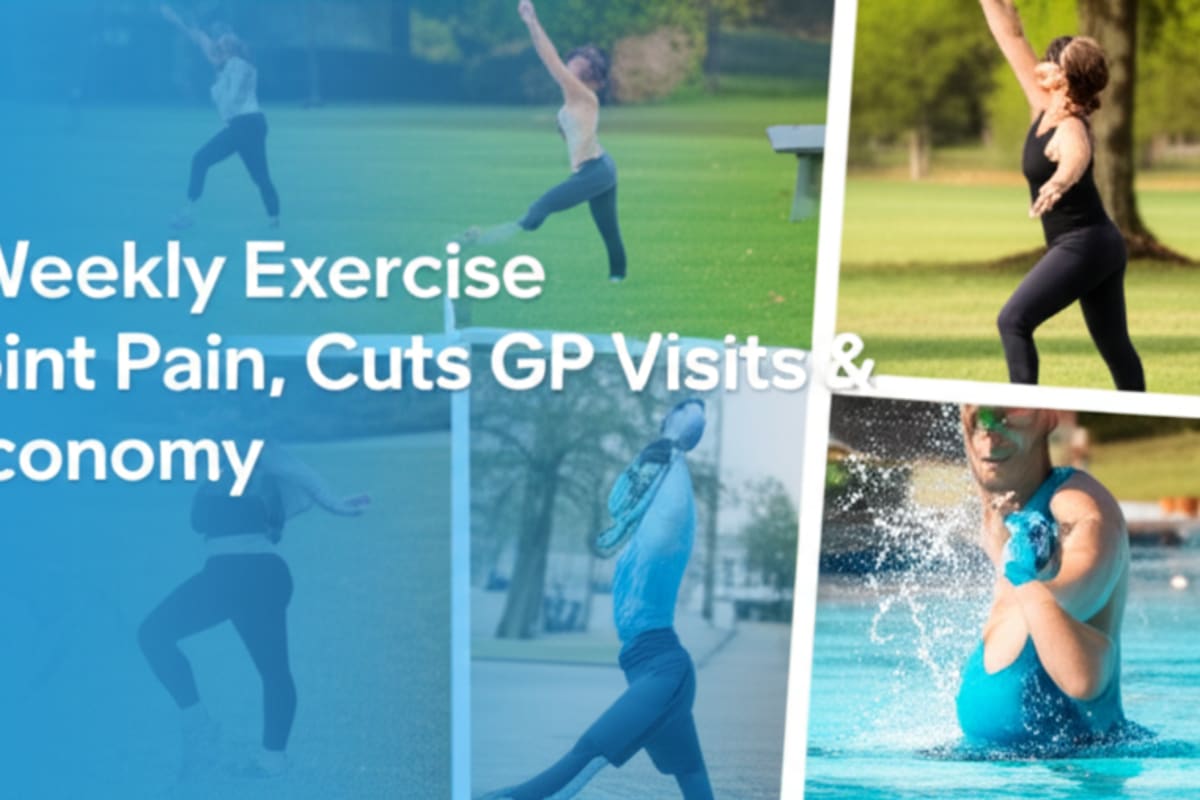2 Hours Weekly Exercise Halves Joint Pain, Cuts GP Visits & Boosts Economy

The pervasive issue of chronic joint pain, affecting millions worldwide, has long been a drain on healthcare systems and individual productivity.
Background
However, groundbreaking research from the UK offers a simple, yet profoundly effective, solution: just two hours of exercise a week
This comprehensive study not only quantifies the direct benefits for individuals suffering from hip, knee, or back pain but also highlights a staggering economic advantage, potentially saving the UK economy an estimated £34 billion
Published on October 5, 2025, the findings stem from an extensive analysis involving 40,000 participants across Greater Manchester
These individuals, all grappling with persistent joint pain, engaged in a structured exercise program consisting of two one-hour classes per week over a 12-week period
The results were compelling and indicative of a paradigm shift in pain management strategies
Transformative Personal OutcomesParticipants reported an average reduction of 35% in their pain levels. This is a substantial improvement, translating to a significant enhancement in quality of life for those previously limited by chronic discomfort.
Beyond pain alleviation, the ripple effects were equally impressive:Reduced GP Visits: Individuals sought medical attention from their general practitioners 29% less often
This not only frees up valuable healthcare resources but also indicates a greater sense of self-efficacy and improved health management among patients
Decreased Sick Leave: The economic impact on the workforce was undeniable, with participants taking almost half as many sick days from work.
This points to enhanced productivity and reduced burden on employers
Less Caregiver Dependency: The study also revealed a 21% reduction in the need for family members to provide care.
This underscores the broader societal benefit, alleviating stress and responsibility on informal caregivers and promoting greater independence for those with chronic conditions
These statistics paint a clear picture: regular, moderate exercise is not merely a supplementary therapy but a core intervention for managing musculoskeletal pain, offering a pathway to improved physical function, mental well-being, and overall autonomy
The Mechanisms Behind the MiraclesThe benefits of exercise extend beyond simple distraction from pain
Physical activity, particularly structured programs, works on multiple physiological fronts:Muscle Strengthening: Stronger muscles around joints (like the quadriceps for knees or core for the back) provide better support, absorb shock, and reduce the load on cartilage and ligaments
Improved Flexibility and Range of Motion: Regular movement helps maintain joint lubrication, reducing stiffness and improving the ability to perform daily tasks
Weight Management: Exercise contributes to weight loss, which significantly reduces stress on weight-bearing joints like the hips and knees.
Reduced Inflammation: Physical activity has systemic anti-inflammatory effects, which can mitigate the underlying causes of chronic joint pain, especially in conditions like osteoarthritis
Enhanced Blood Flow: Improved circulation delivers essential nutrients to joint tissues and aids in waste removal.
Endorphin Release: Exercise triggers the release of endorphins, natural pain-relieving hormones that also improve mood and combat the psychological distress often associated with chronic pain
Economic Implications: A £34 Billion WindfallThe study's projection of a £34 billion benefit to the UK economy is not merely a number; it represents the tangible value derived from reduced healthcare expenditures, increased workforce productivity, and a more independent, healthier population
This figure encapsulates savings from fewer GP visits, less reliance on medication, decreased need for specialist interventions, and the cumulative economic output gained from fewer sick days
It serves as a powerful argument for governments and health policymakers globally to invest in preventative and rehabilitative exercise programs.
Contextualizing for Southeast AsiaWhile the study originates from the UK, its implications resonate deeply within Southeast Asia
The region is experiencing rapid demographic shifts, with an aging population leading to a rising prevalence of non-communicable diseases, including musculoskeletal conditions like osteoarthritis and chronic back pain
Lifestyle changes, including increased sedentary behavior and rising obesity rates, further exacerbate these issues
Healthcare Burden: Healthcare systems across Southeast Asia, from bustling metropolises to rural communities, face immense pressure.
Integrating cost-effective interventions like structured exercise could significantly alleviate this burden, reducing reliance on expensive medications, surgeries, and long-term care
Cultural Nuances & Accessibility: While exercise is generally valued, access to structured, medically-guided programs may vary.
Traditional practices and remedies often coexist with modern medicine
Public health campaigns would need to be culturally sensitive, perhaps integrating exercise into community events, leveraging local health centers, or promoting activities popular in the region (e
, tai chi, brisk walking in parks)
Workplace Productivity: With dynamic economies, maintaining a healthy and productive workforce is crucial.
Initiatives to promote physical activity in workplaces, similar to the UK's potential economic gains, could yield substantial returns for nations like Singapore, Malaysia, Thailand, and Indonesia
Policy Imperatives: Governments and health ministries in Southeast Asia could draw inspiration from this study to prioritize physical activity within their national health strategies
This could involve funding community exercise programs, training primary care providers to 'prescribe' exercise, developing accessible public fitness facilities, and launching widespread public awareness campaigns
This study offers critical insights into the profound individual and societal benefits of regular physical activity, specifically for chronic joint pain
Globally, particularly in Southeast Asia, these findings are immensely valuable
They underscore a cost-effective, preventative, and therapeutic approach that can reduce healthcare expenditure, enhance workforce productivity, and improve the quality of life for millions, requiring governments to consider integrating exercise programs into primary care and public health strategies
Actionable Insights for a Healthier FutureHere are key takeaways for different stakeholders:For Individuals: If you suffer from joint pain, consult your GP or a physiotherapist to explore suitable exercise programs
Even moderate activity, such as brisk walking, swimming, cycling, or dedicated strength training, can make a profound difference
Consistency is key.
For Healthcare Providers: Integrate exercise prescriptions as a primary recommendation for patients with chronic joint pain, alongside or even prior to pharmacological interventions
Referrals to community exercise programs or physiotherapists should be standard practice. For Policymakers & Employers: Invest in public health campaigns promoting physical activity.
Fund accessible community-based exercise programs. Encourage workplace wellness initiatives that include opportunities for physical activity and education on its benefits.
The economic returns are substantial and proven.
In conclusion, the message from Greater Manchester is clear and universally applicable: two hours of exercise a week is not just a personal health choice; it's a powerful public health imperative with the potential to alleviate suffering, empower individuals, and significantly bolster national economies
For Southeast Asia, embracing these findings could be a vital step towards building more resilient, healthier, and productive societies.
